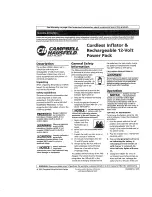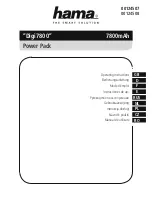
3
f)
Dress properly. Do not wear loose clothing or jewelry. Keep your hair, clothing and gloves
away from moving parts.
Loose clothes, jewelry or long hair can be caught in moving parts.
g)
If devices are provided for the connection of dust extraction and collection facilities, ensure
these are connected and properly used.
Use of dust collection can reduce dust-related hazards.
4) POWER TOOL USE AND CARE
a)
Do not force the power tool. Use the correct power tool for your application.
The correct
power tool will do the job better and safer at the rate for which it was designed.
b)
Do not use the power tool if the switch does not turn it on and off.
Any power tool that
cannot be controlled with the switch is dangerous and must be repaired
.
c)
Disconnect the plug from the power source and/or the battery pack from the power tool
before making any adjustments, changing accessories, or storing power tools.
Such
preventive safety measures reduce the risk of starting the power tool accidentally.
d)
Store idle power tools out of the reach of children and do not allow persons unfamiliar
with the power tool or these instructions to operate the power tool.
Power tools are
dangerous in the hands of untrained users.
e)
Maintain power tools. Check for misalignment or binding of moving parts, breakage of parts
and any other condition that may affect the power tool’s operation. If damaged, have the power
tool repaired before use.
Many accidents are caused by poorly maintained power tools.
f)
Keep cutting tools sharp and clean.
Properly maintained cutting tools with sharp cutting edges
are less likely to bind and are easier to control.
g)
Use the power tool, accessories and tool bits, etc. in accordance with these instructions,
taking into account the working conditions and the work to be performed.
Use of the power
tool for operations different from those intended could result in a hazardous situation.
5)
SERVICE
a)
Have your power tool serviced by a qualified repair person using only identical replacement
parts.
This will ensure that the safety of the power tool is maintained.
Additional Safety Instructions
IMPORTANT SAFETY INSTRUCTIONS FOR HEAT GUNS
1. Remember that hidden areas such as those behind walls, ceilings, floors, soffit boards
and other panels may contain flammable materials that could be accidentally ignited
when stripping paint from the panel. Such a fire would not be readily apparent, and could
cause considerable damage and danger of injury. This heat gun is capable of producing
temperatures in excess of 1000° F (538° C).
2. Do not use this tool as a hair dryer.
3.
Alwaysturnheatgunoff,disconnectfrompowersourceandletthetoolcooldownforatleast30
minutesbeforemovingorstoringit.
Donotlaytheheatgunonflammablesurfaceswhenoperating
thegunorimmediatelyaftershuttingitoff.Alwayssetthegunonaflatlevelsurfacesothatthe
nozzletipispointedupwardwhenallowingtocool.
Foreasystorage,thetoolcanhangfromthe
hanghole.Theheatgunshouldbestoredindoors.
4. Always use good quality scrapers and stripping knives.
5. Never obstruct the air intake or nozzle outlet.
6. Besuretodirectthehotairblastinasafedirection;awayfromotherpeopleorflammableobjects.
7. Keep fingers away from metal nozzle; it becomes very hot.
8. Donʼt touch the nozzle to any surface while running or shortly after running.
9. Avoid poking anything down inside the nozzle.
10. Know your work environment. Remember that areas behind soffit board, ceilings, and
floors may contain highly flammable materials. Check these areas before applying heat.
11. Clean dry paint from the nozzle after use; it could ignite.
12. Clean your scraper blade frequently during use; it could ignite.
13. Do not use the heat gun in combination with chemical strippers.
14. Do not use accessory nozzles as scrapers.
15. Keep nozzle away from cord.
16. Do not use to cook or warm food.




































